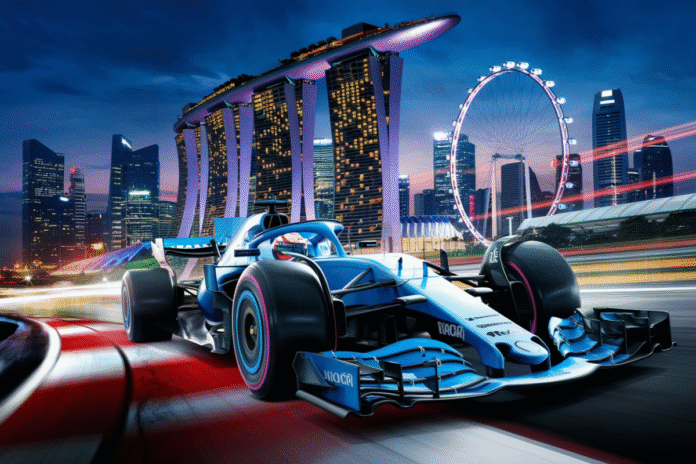“This weekend, Formula 1 will implement a significant change at the Singapore Grand Prix.” The decision to trial a higher pit-lane speed limit has the potential to disrupt traditional racing strategies. In a sport where every second counts, this new regulation raises questions about its implications for team tactics and driver performance. Will this adjustment lead to more competitive races, or will it complicate the already intricate strategies teams employ during a Grand Prix?
The stakes are high as teams prepare for this unprecedented change. A higher pit-lane speed limit could alter the dynamics of pit stops, which are critical moments in any race. Teams must now reassess their strategies, taking into account the potential for faster pit stops while balancing the risk of penalties for exceeding the new limit. As the drivers face this challenge, fans eagerly anticipate whether this adjustment will lead to thrilling overtakes and unexpected outcomes on the track.
Understanding the New Pit-lane Speed Limit
The introduction of a higher pit-lane speed limit is a bold move by Formula 1, aiming to enhance the excitement of races. Traditionally, teams have adhered to strict speed regulations in the pit lane to ensure safety and fairness. However, this new trial could significantly change how teams approach their pit strategies. By increasing the speed limit, teams may attempt to minimize the time lost during pit stops, which can be crucial in tightly contested races.
For instance, the current pit-lane speed limit is set at 37 mph (60 km/h). If this limit is raised, teams could potentially shave valuable seconds off their pit stop times. This adjustment could lead to a more aggressive racing style, as drivers push the limits of their vehicles during pit entries and exits. The implications of this change extend beyond mere seconds; they could redefine the competitive landscape of races, forcing teams to adapt quickly to new strategies.
Moreover, the decision to trial this change at the Singapore Grand Prix, known for its unique night race atmosphere and challenging street circuit layout, adds an extra layer of complexity. Teams will need to consider not only the new speed limit but also the track’s characteristics, such as limited overtaking opportunities and the potential for safety car deployments. This multifaceted challenge will test the adaptability and ingenuity of teams as they navigate the new regulations.
Potential Impact on Race Strategies
The impact of a higher pit-lane speed limit on race strategies could be profound. Teams will need to rethink their approach to pit stops, which are often meticulously planned based on tire wear, fuel levels, and track position. With the possibility of quicker pit stops, teams may opt for more aggressive strategies, potentially opting for fewer stops or different tire strategies to capitalize on the increased speed.
Additionally, the psychological aspect of racing cannot be overlooked. Drivers may feel more pressure to push the limits during pit stops, knowing that a faster exit could provide a competitive edge. This change could lead to increased risk-taking, with drivers attempting to gain every possible advantage. As a result, the races may become more unpredictable, with teams and drivers constantly adjusting their strategies based on real-time performance and the evolving dynamics of the race.
Furthermore, the potential for penalties due to speeding in the pit lane could introduce a new layer of strategy. Teams must balance the desire for speed with the risk of incurring time penalties that could negate any gains made during the pit stop. This delicate balancing act will require teams to have a deep understanding of their drivers’ capabilities and the intricacies of the new regulations.
Fan Reactions and Expectations
As the Formula 1 community prepares for this trial, fan reactions have been mixed. Many enthusiasts are excited about the prospect of a more dynamic racing environment, where strategies are constantly evolving and drivers are pushed to their limits. The potential for increased overtaking opportunities and thrilling battles on the track has fans eagerly anticipating the Singapore Grand Prix.
On the other hand, some fans express concerns about the implications of a higher pit-lane speed limit. Safety remains a paramount concern in motorsport, and any changes that could compromise driver safety are met with skepticism. Critics argue that while the intention behind the new limit may be to enhance competition, it could inadvertently lead to more accidents or dangerous situations during pit stops.
Ultimately, the success of this initiative will depend on its execution and the ability of teams and drivers to adapt to the new rules. As the Singapore Grand Prix approaches, all eyes will be on the pit lane to see how this trial unfolds and what it means for the future of Formula 1 racing.
The Future of Formula 1 Regulations
The trial of a higher pit-lane speed limit at the Singapore Grand Prix may signal a broader shift in Formula 1 regulations. The sport has a history of evolving rules aimed at improving competition and enhancing the spectacle for fans. If this trial proves successful, it could pave the way for permanent changes to pit-lane regulations across future seasons.
Moreover, the response from teams, drivers, and fans will play a crucial role in shaping the future of these regulations. If the trial leads to more exciting races and positive feedback, the governing body may consider similar adjustments in other areas, such as tire regulations or race formats. The willingness to experiment with rules reflects a commitment to keeping the sport fresh and engaging for its audience.
As Formula 1 continues to innovate, the balance between safety and competition will remain a critical focus. The introduction of new regulations will require ongoing analysis and adjustments to ensure that the sport remains both thrilling and safe for all participants. The outcome of this trial will undoubtedly influence future discussions about the direction of Formula 1 and its commitment to providing an exhilarating experience for fans worldwide.


